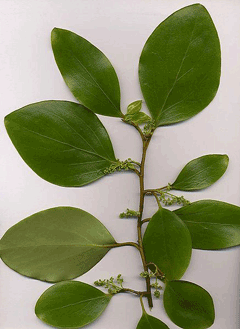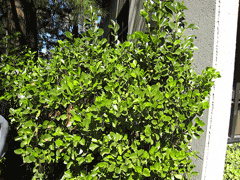 |
|
http://commons.wikimedia.org/wiki/User:Kahuroa |
 |
| http://flickr.com/photos/62614925%40N00 |
Translate this page:
Summary
Physical Characteristics

 Griselinia littoralis is an evergreen Shrub growing to 6 m (19ft) by 5 m (16ft) at a medium rate.
Griselinia littoralis is an evergreen Shrub growing to 6 m (19ft) by 5 m (16ft) at a medium rate.
See above for USDA hardiness. It is hardy to UK zone 7 and is not frost tender. It is in leaf all year, in flower in May. The species is dioecious (individual flowers are either male or female, but only one sex is to be found on any one plant so both male and female plants must be grown if seed is required). . The plant is not self-fertile.
Suitable for: light (sandy) and medium (loamy) soils. Suitable pH: mildly acid, neutral and basic (mildly alkaline) soils. It can grow in semi-shade (light woodland) or no shade. It prefers moist soil. The plant can tolerate maritime exposure.
UK Hardiness Map
US Hardiness Map
Synonyms
Pukateria littoralis.
Plant Habitats
Woodland Garden Sunny Edge; Dappled Shade; Hedge;
Edible Uses
Edible Parts: Fruit
Edible Uses:
Fruit - a bitter flavour[173].
References More on Edible Uses
Medicinal Uses
Plants For A Future can not take any responsibility for any adverse effects from the use of plants. Always seek advice from a professional before using a plant medicinally.
None known
References More on Medicinal Uses
The Bookshop: Edible Plant Books
Our Latest books on Perennial Plants For Food Forests and Permaculture Gardens in paperback or digital formats.

Edible Tropical Plants
Food Forest Plants for Hotter Conditions: 250+ Plants For Tropical Food Forests & Permaculture Gardens.
More

Edible Temperate Plants
Plants for Your Food Forest: 500 Plants for Temperate Food Forests & Permaculture Gardens.
More

More Books
PFAF have eight books available in paperback and digital formats. Browse the shop for more information.
Shop Now
Other Uses
Hedge Hedge Wood
Grows well by the sea, making a good hedge that tolerates maritime exposure[11, 29, 49]. Plants are very amenable to trimming[200], they are best cut in early summer[188] and can be cut right back into old wood if required. A slow-growing plant, but it makes a nice dense hedge[K]. Wood - very durable, firm, dense but slightly brittle. Used for ship building, railway sleepers etc[46, 61, 123].
Special Uses
Hedge Hedge
References More on Other Uses
Cultivation details
Prefers a rich light loam in sun or semi-shade[200]. Tolerates chalky soils[11]. Plants are very tolerant of strong maritime winds[182] but they can be damaged by cold dry winds. Tolerating temperatures down to about -10°c, this species is somewhat tender in most parts of Britain[11] though it usually regrows if cut back by frost[200]. The young shoots in spring are often cut back by late frosts[K]. Very tolerant of root disturbance, it transplants well even when quite large though it would then require staking at first when growing in exposed positions[166]. A number of cultivars have been developed for their ornamental value[182, 200]. Plants in this genus are notably resistant to honey fungus[200]. Dioecious. Male and female plants must be grown if seed is required. It self-sows abundantly in the milder areas of Britain if both sexes are grown[11].
References Carbon Farming Information and Carbon Sequestration Information
Temperature Converter
Type a value in the Celsius field to convert the value to Fahrenheit:
Fahrenheit:
The PFAF Bookshop
Plants For A Future have a number of books available in paperback and digital form. Book titles include Edible Plants, Edible Perennials, Edible Trees,Edible Shrubs, Woodland Gardening, and Temperate Food Forest Plants. Our new book is Food Forest Plants For Hotter Conditions (Tropical and Sub-Tropical).
Shop Now
Plant Propagation
Seed - best sown as soon as ripe in a greenhouse. It can also be sown in the spring in a cold frame. Prick out the seedlings when they are large enough to handle and grow on for at least their first winter in a greenhouse. Plant out in late spring after the last expected frosts and give some protection for their first winter outdoors. Cuttings of half-ripe wood 7 cm with a heel, July/August in a frame. Keep the foliage moist. Pot up in August and overwinter in a sheltered position, planting out in late spring after the last expected frosts[78]. Cuttings of mature wood, 7 - 10 cm with a heel, October/November in a frame. High percentage[78].
Other Names
If available other names are mentioned here
Native Range
AUSTRALASIA: New Zealand (North Island, South Island, Stewart Island)
Weed Potential
Right plant wrong place. We are currently updating this section.
Please note that a plant may be invasive in one area but may not in your area so it's worth checking.
Conservation Status
IUCN Red List of Threatened Plants Status :

Growth: S = slow M = medium F = fast. Soil: L = light (sandy) M = medium H = heavy (clay). pH: A = acid N = neutral B = basic (alkaline). Shade: F = full shade S = semi-shade N = no shade. Moisture: D = dry M = Moist We = wet Wa = water.
Now available:
Food Forest Plants for Mediterranean Conditions
350+ Perennial Plants For Mediterranean and Drier Food Forests and Permaculture Gardens.
[Paperback and eBook]
This is the third in Plants For A Future's series of plant guides for food forests tailored to
specific climate zones. Following volumes on temperate and tropical ecosystems, this book focuses
on species suited to Mediterranean conditions—regions with hot, dry summers and cool, wet winters,
often facing the added challenge of climate change.
Read More
Expert comment
Author
Raoul.
Botanical References
1144200
Links / References
For a list of references used on this page please go here
Readers comment
© 2010, Plants For A Future. Plants For A Future is a charitable company limited by guarantee, registered in England and Wales. Charity No. 1057719, Company No. 3204567.